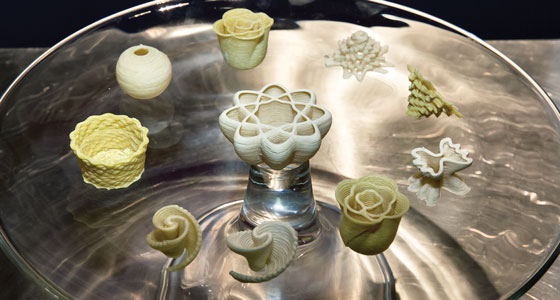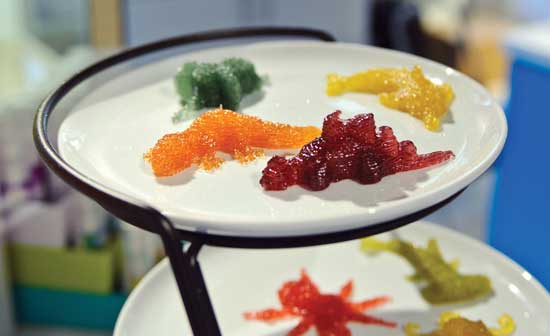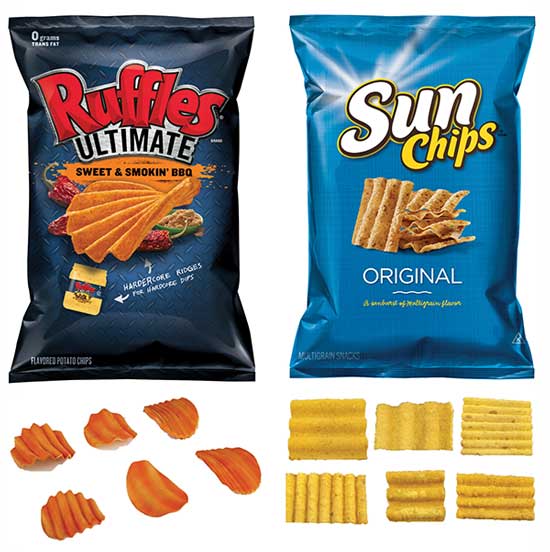How 3-D Printing Will Shape Food Product Development
This cutting-edge technology has applications that include rapid prototyping, process design, packaging, and at-home food preparation.

3-D printing is a much talked about technology that promises to revolutionize the way we currently make things. Sometimes also referred to as additive manufacturing, it is a process where a material is deposited layer by layer in a specific pattern to make a three-dimensional object. The process is electronically controlled and can technically make any design that can be drawn by the software.
There are several different methods and technologies, such as stereolithography, which is laser sintering or fused deposition. Most of the processes involve either depositing or fusing materials in a desired shape, typically melting and solidifying the material used. The kind of technology used determines the type of material and its properties that can be used for printing. A significant amount of work has been done in broadening the range of materials, which were initially limited to plastics. Metal and even wood has been successfully used to create 3-D printed objects.
Some of the materials used in 3-D printers have been edible, giving rise to the idea of 3-D printing food. One of the first such materials was chocolate for the obvious reasons that it is easy to deposit in a melt form and then set by simply cooling it down. But recently other materials such as sugar and even dough have been used, and in some applications, a post-cooking step is required.
Benefits and Applications of 3-D Printing
3-D printing has been used in several areas where its unique benefits provide an advantage for both traditional and food applications.
It can create complex shapes that may not be cost-effective or even be possible using other technologies. Additional complexity may not even impact the cost and time of producing the object beyond the effort of creating the drawing. In applications such as aerospace, complex shapes can be fabricated feasibly, which can save additional weight. Artists and designers have used 3-D printing in art and fashion. Similarly, food 3-D printers have been used to create unique edible shapes, primarily as novelties.
3-D printing makes customization much more affordable. Products can feasibly be made in smaller numbers instead of mass production. For example, it can be used to create shoes that fit perfectly for each individual athlete or prosthetics customized for each individual. In food applications, customization can be used not just for shapes; a food printer loaded with multiple ingredients can also formulate products based on individual nutritional needs.
While it is slower than mass production, 3-D printing can be much faster than other methods in prototyping. Subsequently, one of the most established applications of 3-D printing has been in rapid prototyping where several iterations of a design can be quickly produced during the development phase to better optimize the final product that needs to be manufactured employing user feedback. This has been applied successfully in several industries such as automotive and architecture.
One of the largest impacts of 3-D printers has been in convenience. Desktop-size 3-D printers are affordable for use at home where anyone can create solid objects using a variety of different materials. This has been a huge benefit in fields such as research or robotics and has fueled the “maker” movement of consumers making their own products (Matias and Rao 2015). Similarly, a long-term promise of food 3-D printers is to be able to put a vast range of culinary dishes at our fingertips with the press of a button.
How Current Limitations Are Being Addressed
While the impact of 3-D printing has already been significant in multiple industries, a lot of work is still being done to further broaden its application. It still requires specific properties, which limits the range of material that can be used. The same is true for food applications. Most of the current machines are extrusion-based and use materials such as chocolate that can be easily extruded and change states. Dough has been used to make 3-D shapes, which can be subsequently cooked. Other technologies such as sintering have also been used with sugar since it can be easily melted. However, ingredients such as meats and vegetables, which cannot be extruded or melted, can only be used in complex formulations to make them usable in 3-D printing (Sun et al. 2015).
There have been significant strides made in the speed and cost of 3-D printers, which has made the overall cost of fabrication come down rapidly. However, it is still not as cheap as mass production of everyday objects that are simple to make. For example, it is still cheaper to use blow molding to make a large amount of plastic bottles versus 3-D printing them. Similarly, mass production of food is a very efficient and cost-optimized process that will be tough to replicate.
Additionally, fabricating foods also brings its unique challenges. Beyond shape and appearance, our perception of food consists of flavor and texture. To replicate all aspects of food that we are used to will require new breakthroughs in the materials as well as the structures that can be created using 3-D printing.
--- PAGE BREAK ---
 3-D Printing in the Food Industry
3-D Printing in the Food Industry
While 3-D printing is starting to be applied in several manufacturing processes, food printing has been limited to specialized applications. However, just as 3-D printing was first established in research applications, it is also being adopted in food industry R&D for new product development.
The typical process of new product development consists of several stages. Initial consumer insights inform the developer of consumer needs and the kind of product that needs to be developed. Prototyping is then usually carried out at a small scale to translate the concept into a physical product followed by process development and scale-up to identify a large-scale process that can create the product. This is usually an iterative process where consumer feedback and input is sought at every stage to ensure that the product can eventually deliver the specific need and will generate enough purchase interest to be a success. Once the product and process are defined and specified, they are commercialized to be produced consistently for launch in the marketplace. There are several ways 3-D printing is being used by various companies during each of these stages of development.
• Consumer Insights and Prototyping. During the early stages, R&D teams work closely with consumer insights to gather consumer information to define what the consumer is looking for and translate that into the product attributes that can address those needs. It can be an iterative process where prototypes need to be reviewed with consumers for feedback to ensure it is optimized for the concept. This is a slow process since prototyping typically requires significant time and resources.
 One of the key attributes of a product is appearance, which includes shape and size. Rapid prototyping using 3-D printing has been used to create models of the product in order to get consumer feedback (Figure 1). This is much more impactful compared with using images that cannot simulate a consumer’s experience of being able to hold the product in his or her hands. The models also need not be edible to generate useful data, which allows us to use plastics, which are well established in 3-D printing technology. This can significantly minimize the time and resources typically required, and since a large number of options can be quickly tested with consumers, it can also ensure that an optimal shape and size is identified.
One of the key attributes of a product is appearance, which includes shape and size. Rapid prototyping using 3-D printing has been used to create models of the product in order to get consumer feedback (Figure 1). This is much more impactful compared with using images that cannot simulate a consumer’s experience of being able to hold the product in his or her hands. The models also need not be edible to generate useful data, which allows us to use plastics, which are well established in 3-D printing technology. This can significantly minimize the time and resources typically required, and since a large number of options can be quickly tested with consumers, it can also ensure that an optimal shape and size is identified.
Another aspect of product design is packaging. Packaging prototypes can be created more easily using 3-D printing for rapid consumer testing.
• Product/Process Development. At this stage, R&D teams work to develop a commercial-scale process, which can deliver the optimal prototyping identified in the previous stage. If changes are necessary to the product design, consumer input could be sought again. The equipment and process design is also an iterative process, and multiple designs may need to be tested before identifying the configuration that delivers the closest fit to the consumer-optimized design. Again 3-D printing is starting to be leveraged to create test parts, drastically reducing the lead time for fabrication, saving both costs and resources
• Scale-Up and Commercialization. During commercial production, the key metric is to be able to reliably deliver the product design. Quality control is critical and requires several attributes of the products to be continuously monitored and measured. Due to the advances in the field of 3-D technology, new tools such as 3-D scanning are now readily available. These allow one to accurately measure attributes like volume and surface area that cannot be quickly measured using conventional methods. These new capabilities can enable us to more accurately specify the product and put the right control steps in place to ensure our product quality is more consistent. Some of the measurements can also be implemented online, opening up possibilities for automation.
The Future of Food 3-D Printing
3-D printing is still a young technology but as the costs lower, efficiencies improve, and the range of materials broaden, it is starting to find more applications in manufacturing. However, the more significant utility could still be in consumer end fabrication. With low-cost 3-D printers, everybody has access to fabricating objects at home for any given purpose.
3-D printing with food is even more novel and could follow a similar path of application. As the technology advances, we could find ways to apply 3-D printing beyond specialty uses and in larger-scale manufacturing of food products. Meanwhile, companies such as Foodini and Chefjet are focusing on small-scale applications that could have potential for household use. Consumer end application of food printing will need to rely on delivering convenience. However, several challenges still need to be overcome if the objective is to deliver food products we are familiar with today. Delivering the right nutrition while matching the texture and flavor of what we are used to today using 3-D technology is a formidable task and will require several breakthroughs to make it possible.
Just as 3-D printing was first adopted in research and development in several industries such as automotive and architecture for rapid prototyping, it is also impacting product development in the food industry. Realistic models of snacks and other food products can help get better consumer feedback on product appearance. Equipment parts made using 3-D printing can speed up prototyping and scale-up processes. We could also use it to manufacture customized food packaging in the future.
3-D printing has already been a breakthrough and we continue to find new ways of using it. Fabricating food has been exciting, but there are still multiple opinions on how it could change our lives. The ultimate vision still evokes what so far has been a frequent fixture in science fiction—delicious food made from scratch at the touch of a button. But we are still a long way away from replacing our age-old methods of cooking and preparing. Until this technology can mimic the foods we are used to eating, its acceptance will require changing human behavior, which is always a challenge.
Anshul Dubey is an employee of PepsiCo Inc. The views expressed in this article are those of the author and do not necessarily reflect the position or policy of PepsiCo Inc.
Anshul Dubey, PhD, a member of IFT, is R&D Senior Manager at PepsiCo, Plano, Texas ([email protected]).
References
Matias, E. and B. Rao. 2015. “3D Printing: On Its Historical Evolution and the Implications for Business,” Proceedings of PICMET ‘15: Management of the Technology Age. IEEE. doi:10.1109/PICMET.2015.7273052.
Sun, J., Z. Peng, W. Zhou, J. Y. H. Fuh, G. S. Hong, and A. Chiu. 2015. “A Review on 3D Printing for Customized Food Fabrication.” 43rd Proceedings of the North American Manufacturing Research Institution of SME. Procedia Manufacturing 30: 1–12.
